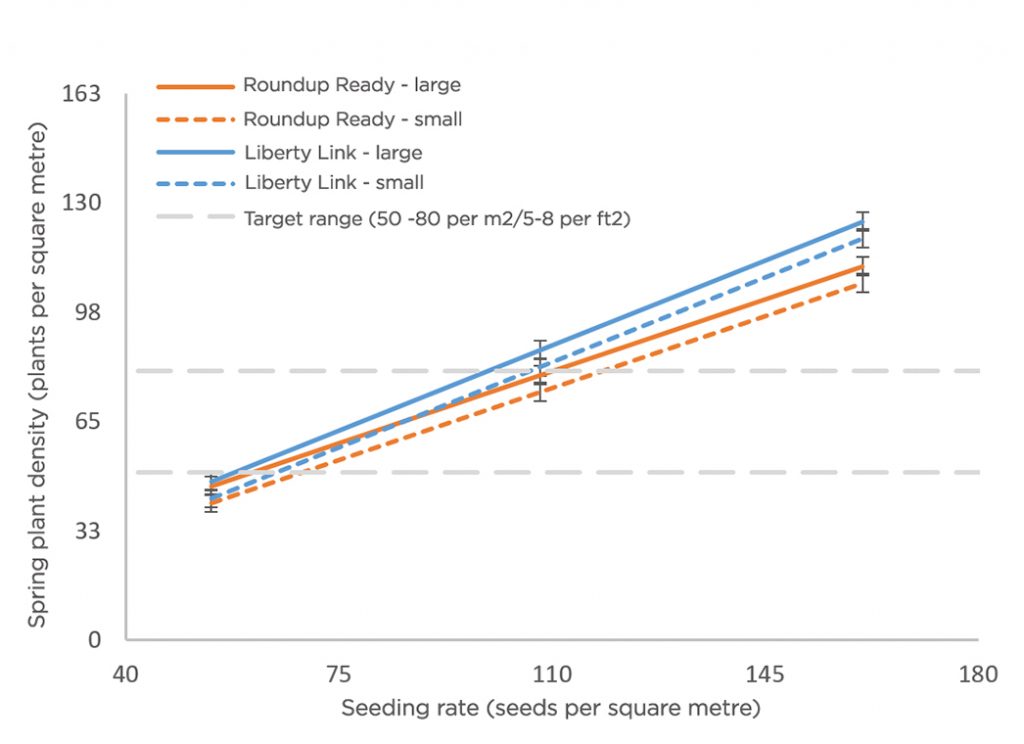Hybrid and seed lot choice could influence seeding rate
KEY RESULT:
This study compared three canola seeding rates (5, 10 and 15 seeds per square foot) with small and large seed size lots from two different hybrids.
It concluded that the most economic and least risky seeding rate to achieve adequate plant stand population is about 10 seeds per square foot because the response to seeding rate differed between hybrids and
seed sizes.
PROJECT TITLE, PRINCIPAL INVESTIGATOR:
“Optimal Seeding Rate Based On Seed Size In Canola,” Christiane Catellier, Indian Head Agricultural Research Foundation
FUNDING: SaskCanola
Every farm and every field is different, so blanket recommendations for canola seeding rate and stand establishment is difficult. Research was conducted in 2018 to build upon previous seeding rate trials to determine optimal seeding rate across various environmental conditions in Saskatchewan, and to determine if seeding rate varies with seed size and hybrids.
The Canola Council of Canada recommends a canola seeding rate that targets a stand establishment of five to eight plants square foot (50 to 80 plants/m2). This plant stand allows for in-season plant losses due to stresses such as insect, frost or disease while maintaining the four to five plants per square foot population required to reach maximum canola yield. Seed size also varies considerably between and within hybrid seed lots, and is a major factor in establishing seeding rate based on thousand seed weight.
A small-plot field trial was conducted at five Saskatchewan locations (Indian Head, Yorkton, Melfort, Scott,and Outlook). The trial included two hybrid canola varieties, one Liberty Link and one Roundup Ready. Each variety had seed sourced from two seed lots, one with smaller seed and one with larger seed. For the Liberty Link hybrid, small seed was 4.3 grams per thousand seeds and large was 5.5 grams. For the Roundup Ready, small was 4.8 grams and large was 5.9 grams. All four seed lots (LL large and small, RR large and small) were sown at seeding rates of five, 10 and 15 seeds per square foot.
In general, all locations experienced above-average temperatures and below-normal precipitation in 2018. Emergence rates were very high at all locations in 2018, and in-season mortality was minimal. As a result, seeding rates required to achieve adequate plant populations and optimum yield were likely lower than would be expected.
The recommended target spring plant density of five to eight plants per square was attained by seeding at 10 plants per square foot for all four seed lots. Per cent emergence and per cent survival decreased with higher seeding rates, which is typical, but the rate of decrease differed between seed lots. Also, as seeding rate increased, days to maturity decreased by up to two days.
Figure 1. Use enough seed to meet target stand

Yield response varied between hybrids.
Yield of the Liberty Link hybrid did not respond to seeding rate or resulting plant population, and was not affected by seed size. Yield of the Roundup Ready hybrid was significantly lower with a smaller seed lot, and the yield was optimized at the moderate seeding rate. However, if emergence and survival rates had not been so good in 2018, a greater yield penalty may have occurred with lower seeding rates.
The research concluded that the most economic and least risky seeding rate to achieve adequate plant population was found to be 10 seeds per square foot. Growers could also consider using larger seed lots, or a slightly higher seeding density with smaller seeds lots to optimize yield. The effect of seed size may or may not be important depending on the hybrid.





